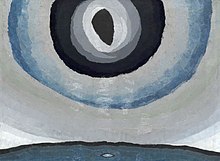20:
50:
Titanium dioxide (TiO2) is a bright white substance first named and created in a laboratory in the late 1800s. It is called titanium white, Pigment White 6 or CI 77891 when used specifically as a pigment in paints and was initially used as a pigment in the ceramic arts for yellow glazes. The pigment
67:
Titianium white provides greater hiding power and tinting strength than any other white pigment. Titanium white was initially more expensive to produce than lead white, but its superior hiding power soon made it a more economical choice because smaller quantities were required to achieve the same
42:. Though the term titanium white most often refers to pigments containing titanium dioxide, it can also describe any white pigment that contains a titanium compound (e.g. zinc titanate, barium titanate, potassium titanate, titanium lithopone, titanium silicate).
51:
was further developed for industrial use in the 1910s by the
Titanium Pigment Company in the United States and the Titan Company in Norway, each working independently. The two manufactures cross-licensed their patents in 1920. By the late 1920s, titanium and
215:
59:
as the dominant product in the market for white pigment. Most art supply companies now explicitly advise that titanium white should be used instead of lead white for safety reasons.
241:"Revealing the Nature and Distribution of Metal Carboxylates in Jackson Pollock's Alchemy (1947) by Micro-Attenuated Total Reflection FT-IR Spectroscopic Imaging"
239:
Gabrieli, Francesca; Rosi, Francesca; Vichi, Alessandra; Cartechini, Laura; Pensabene Buemi, Luciano; Kazarian, Sergei G.; Miliani, Costanza (2017).
38:. It is the most widely used white pigment in contemporary artistic applications because of its affordability, low toxicity, and high
81:
292:
302:
169:
Wimsatt, J. (1982). "Wax
Emulsion, Tempera or Oil? Arthur Dove's Materials, Techniques, and Surface Effect".
216:"Analyses de pigments blancs appliquées à I'étude chronologique des peintures de chevalet-blanc de titane"
80:, who was among its earliest adopters in the 1920s. It has also been identified in the work of
297:
268:
260:
252:
35:
93:
240:
199:
Heller, B. (1988). "The
Conservation of Diego Rivera's Detroit Industry Fresco Cycle".
19:
286:
124:
Laver, Marilyn (1997). "Titanium
Dioxide Whites". In Fitzhugh, Elisabeth West (ed.).
89:
85:
39:
256:
77:
56:
52:
264:
272:
27:
1929. The painting is an early documented instance of titanium white's use.
184:
Branchick, T.; Braun, E. (1985). "The
Restoration of 'America Today'".
126:
Artists' Pigments: A Handbook of Their
History and Characteristics
18:
141:
Deceit and Denial: The Deadly
Politics of Industrial Pollution
76:
Titanium white featured regularly in the palette of
34:
is a family of white pigments composed primarily of
188:. Williams College Museum of Art. pp. 66–82.
201:American Institute for Conservation: Preprints
186:Thomas Hart Benton: The 'America Today' Murals
171:American Institute for Conservation: Preprints
143:. University of California Press. p. 54.
8:
119:
117:
115:
113:
111:
109:
128:. Vol. 3. Archetype. pp. 295–355.
16:White pigment invented in the 20th century
139:Markowitz, Gerald; Rosner, David (1987).
156:Color: A Natural History of the Palette
105:
7:
220:www.icom-cc-publications-online.org
14:
1:
257:10.1021/acs.analchem.6b04065
158:. Random House. p. 111.
319:
154:Finlay, Victoria (2002).
63:Visual characteristics
28:
22:
245:Analytical Chemistry
214:Coupry, C. (1987).
72:Notable occurrences
68:degree of opacity.
293:Inorganic pigments
82:Thomas Hart Benton
29:
310:
277:
276:
251:(2): 1283–1289.
236:
230:
229:
227:
226:
211:
205:
204:
196:
190:
189:
181:
175:
174:
166:
160:
159:
151:
145:
144:
136:
130:
129:
121:
36:titanium dioxide
318:
317:
313:
312:
311:
309:
308:
307:
303:Shades of white
283:
282:
281:
280:
238:
237:
233:
224:
222:
213:
212:
208:
198:
197:
193:
183:
182:
178:
168:
167:
163:
153:
152:
148:
138:
137:
133:
123:
122:
107:
102:
94:Jackson Pollock
74:
65:
48:
17:
12:
11:
5:
316:
314:
306:
305:
300:
295:
285:
284:
279:
278:
231:
206:
191:
176:
161:
146:
131:
104:
103:
101:
98:
73:
70:
64:
61:
47:
44:
32:Titanium white
15:
13:
10:
9:
6:
4:
3:
2:
315:
304:
301:
299:
296:
294:
291:
290:
288:
274:
270:
266:
262:
258:
254:
250:
246:
242:
235:
232:
221:
217:
210:
207:
202:
195:
192:
187:
180:
177:
172:
165:
162:
157:
150:
147:
142:
135:
132:
127:
120:
118:
116:
114:
112:
110:
106:
99:
97:
95:
91:
90:Pablo Picasso
87:
83:
79:
71:
69:
62:
60:
58:
55:had unseated
54:
45:
43:
41:
37:
33:
26:
23:Arthur Dove,
21:
248:
244:
234:
223:. Retrieved
219:
209:
200:
194:
185:
179:
170:
164:
155:
149:
140:
134:
125:
86:Diego Rivera
75:
66:
49:
40:hiding power
31:
30:
24:
78:Arthur Dove
25:Silver Sun,
287:Categories
225:2022-12-31
100:References
57:lead white
53:zinc white
265:0003-2700
173:: 183–88.
298:Pigments
273:28035811
203:: 85–98.
46:History
271:
263:
92:, and
269:PMID
261:ISSN
253:doi
289::
267:.
259:.
249:89
247:.
243:.
218:.
108:^
96:.
88:,
84:,
275:.
255::
228:.
Text is available under the Creative Commons Attribution-ShareAlike License. Additional terms may apply.
